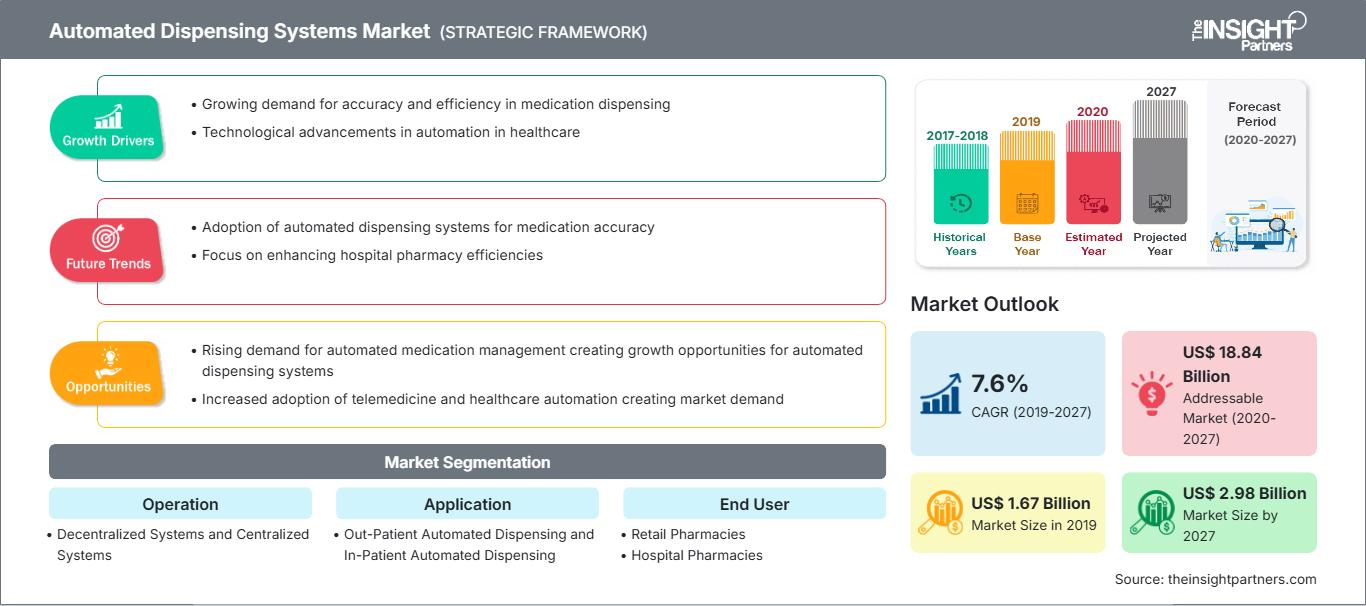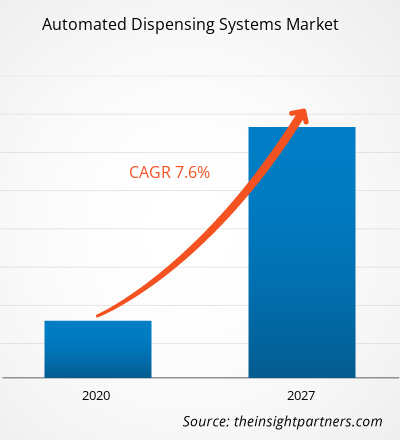The automated dispensing systems market is expected to reach US$ 2,980.38 million by 2027 from US$ 1,665.78 millionin 2019; it is estimated to grow at a CAGR of 7.6% during 2020–2027.
Automated dispensing system, also termed as automated drug cabinets, are electronic drug storage and dispensing devices, primarily used in healthcare settings. These systems aid in tracking and controlling the drug distribution;they are secured with authenticated passwords and biometrics for inventory control and security of the drugs against thefts. These systems have been highlighted as one of the potential instruments to improve operational efficiency and patient safety.Moreover, they are now widely used in clinics and nursing homes, among others. Automated dispensing systems help transform hospitals into safer, and more efficient and effective institutions.
The global automated dispensing systems market is driven by factors such as increasing medication errorsand rising geriatric population. However, the problems associated with automated dispensing systems such as wrong programme input, equipment breakdown and othersmay hinder the market growth. Additionally, emerging markets are creating growth opportunities for the market players.
Customize This Report To Suit Your Requirement
You will get customization on any report - free of charge - including parts of this report, or country-level analysis, Excel Data pack, as well as avail great offers and discounts for start-ups & universities
Automated Dispensing Systems Market: Strategic Insights

-
Get Top Key Market Trends of this report.This FREE sample will include data analysis, ranging from market trends to estimates and forecasts.
Market Insights
Increasing Medication Errors
An irrational, inappropriate, and ineffective medication dispensing may lead to serious medication errors that can harm patients. A few of the common medication errors are dispensing a wrong drug, dispensing a wrong drugquantity, dispensing wrong strength drug, and item omission. ~75% of the medication errors are caused by distractions, as the healthcare professionals are engaged with multiple tasks such as examination of patients, speaking to consultants, speaking to patient family members, conversing with insurance professionals.
Annually, the US Food and Drug Administration (FDA) receives over 100,000 reports associated with medication error. Further, as per the study “Medication Errors” published in StatPearls in June 2020, every year ~7,000–9,000 people die due to medication errorin the US. Similarly, as per the estimations published in the study “Prevalence and Economic Burden of Medication Errors in the NHS In England” in 2018, every year ~237 million medication errors occur in NHS and avoidable adverse drug reactions (ADRs) lead to hundreds of deaths.
Operation-Based Insights
Based on operation, the automated dispensing systems market is segmented into decentralized systems and centralized systems. The centralized systems segment held a larger share of the market in 2019 owing to factors such as growing need to reduce costs, ensure medication availability, and modernize resource allocation.Moreover, decentralized system is anticipated to register a greater CAGR in the market during the forecast period.
Application-Based Insights
Based on application, the automated dispensing systems market is segmented into in-patient automated dispensing and out-patient automated dispensing. The in-patient automated dispensing segment held a larger share of the market in 2019; however, out-patient automated dispensing is anticipated to register a higher CAGR during the forecast period.
End User-Based Insights
Based on end user, the automated dispensing systems market is segmented into hospital pharmacies, retail pharmacies, and others. The hospital pharmacies segment held the largest share of the market in 2019; however, the retail pharmacies segment is expected to register the highest CAGR of in the market during the forecast period.
Product launches and approvalsare the commonly adopted strategies by companies to expand their global footprintsand product portfolios; these strategies help them meet the growing consumer demand. Collaboration is one of the major strategies adopted by the automated dispensing systems marketplayers to enlarge customer base worldwide, which also permits them to maintain their brand name globally.
Automated Dispensing Systems Market Regional Insights
The regional trends and factors influencing the Automated Dispensing Systems Market throughout the forecast period have been thoroughly explained by the analysts at The Insight Partners. This section also discusses Automated Dispensing Systems Market segments and geography across North America, Europe, Asia Pacific, Middle East and Africa, and South and Central America.
Automated Dispensing Systems Market Report Scope
| Report Attribute | Details |
|---|---|
| Market size in 2019 | US$ 1.67 Billion |
| Market Size by 2027 | US$ 2.98 Billion |
| Global CAGR (2019 - 2027) | 7.6% |
| Historical Data | 2017-2018 |
| Forecast period | 2020-2027 |
| Segments Covered |
By Operation
|
| Regions and Countries Covered |
North America
|
| Market leaders and key company profiles |
|
Automated Dispensing Systems Market Players Density: Understanding Its Impact on Business Dynamics
The Automated Dispensing Systems Market is growing rapidly, driven by increasing end-user demand due to factors such as evolving consumer preferences, technological advancements, and greater awareness of the product's benefits. As demand rises, businesses are expanding their offerings, innovating to meet consumer needs, and capitalizing on emerging trends, which further fuels market growth.

- Get the Automated Dispensing Systems Market top key players overview
Global Automated Dispensing Systems Market– by Operation
- Decentralized Systems
- Centralized Systems
Global Automated Dispensing Systems Market– by Application
- Out-Patient Automated Dispensing
- In-Patient Automated Dispensing
Global Automated Dispensing Systems Market– by End User
- Retail Pharmacies
- Hospital Pharmacies
- Others
Automated Dispensing Systems Market– by Geography
-
North America
- US
- Canada
- Mexico
-
Europe
- France
- Germany
- Italy
- UK
- Spain
- Rest of Europe
-
Asia Pacific (APAC)
- China
- India
- South Korea
- Japan
- Australia
- Rest of Asia Pacific
-
Middle East and Africa (MEA)
- South Africa
- Saudi Arabia
- UAE
- Rest of Middle East and Africa
-
South and Central America
- Brazil
- Argentina
- Rest of South America
Company Profiles
- Cerner Corporation
- Capsa Healthcare
- Omnicell, Inc
- BD
- ARxIUM
- Accu-Chart Plus Healthcare Systems, Inc
- Innovation Associates
- RxMedic Systems, Inc
- Swiss log Holding Ltd
- Willach Pharmacy Solutions GmbH
Frequently Asked Questions
Who are the major players in the automated dispensing systemsmarket?
What are the driving factors for the automated dispensing systems marketacross the globe?
What is automated dispensing systems?
- Historical Analysis (2 Years), Base Year, Forecast (7 Years) with CAGR
- PEST and SWOT Analysis
- Market Size Value / Volume - Global, Regional, Country
- Industry and Competitive Landscape
- Excel Dataset
Recent Reports
Testimonials
Reason to Buy
- Informed Decision-Making
- Understanding Market Dynamics
- Competitive Analysis
- Identifying Emerging Markets
- Customer Insights
- Market Forecasts
- Risk Mitigation
- Boosting Operational Efficiency
- Strategic Planning
- Investment Justification
- Tracking Industry Innovations
- Aligning with Regulatory Trends





















 Get Free Sample For
Get Free Sample For